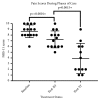Sequential Interventional Management of Osseous Neoplasms via Embolization, Cryoablation, and Osteoplasty
- PMID: 31110519
- PMCID: PMC6487112
- DOI: 10.1155/2019/5247837
Sequential Interventional Management of Osseous Neoplasms via Embolization, Cryoablation, and Osteoplasty
Abstract
The purpose of this study is to determine if sequential interventional therapy can become a mainstay option in providing palliation from fastidious osseous neoplasms in patients with pain refractory to oral analgesia and radiotherapy. This retrospective monocentric study was approved by our institutional review board. Between July 2012 and August 2014, we reviewed 15 patients (6 women, 9 men; age range of 36-81 years) who underwent embolization followed by cryoablation, with or without osteoplasty. Patient demographics and tumor characteristics, including primary histology and the location of metastasis, were included in our review. Pain intensity at baseline, after radiotherapy, and after sequential interventional therapy was reviewed using the hospital electronic medical record. The use of oral analgesia and procedural complications was also noted. Data was then assessed for normality and a two-tailed Student's t-test was performed on mean pain scores for difference phases of treatment. While radiotherapy offers pain relief with a mean pain score of 7.25 ±1.5 (p =<.0001), sequential interventional therapy results in better comfort as demonstrated by a mean pain score of 3.9 ± 2.6 (p=.0015). Moreover, all patients who reported oral analgesic use at presentation reported a decrease in their requirement after sequential interventional therapy. Embolization and cryoablation were performed in all patients, while osteoplasty was indicated in 6 cases. There was no difference in postprocedural pain intensity between patients who required osteoplasty and patients who did not (p = 0.7514). There were no complications observed during treatment. This retrospective study shows that sequential intervention with transarterial embolization, cryoablation, and osteoplasty is both safe and efficacious for bone pain refractory to the current standard of care. We demonstrated that this combination therapy has the potential to become an effective mainstay treatment paradigm in the palliative care of osseous neoplasm to improve quality of life.
Figures




References
-
- Goetz M. P. Percutaneous image-guided radiofrequency ablation of painful metastases involving bone: a multicenter study. Journal of Clinical Oncology. 2004;22(2):300–306. - PubMed
LinkOut - more resources
Full Text Sources

